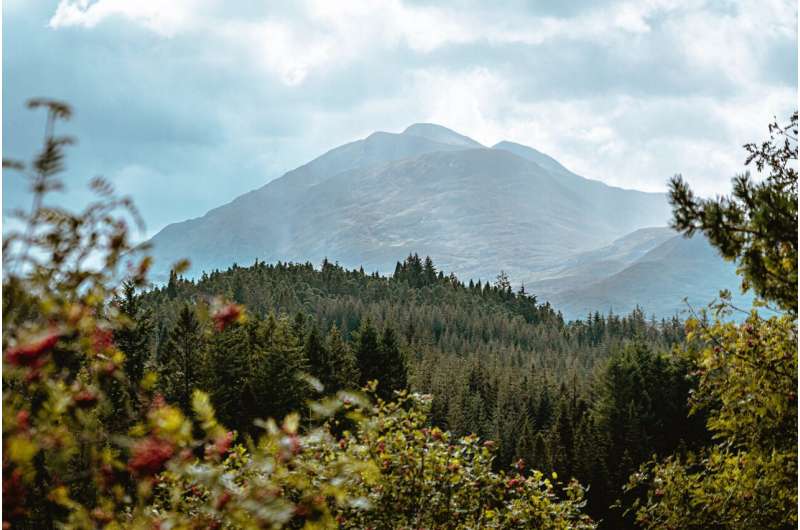This article has been reviewed according to Science X's editorial process and policies. Editors have highlighted the following attributes while ensuring the content's credibility:
fact-checked
trusted source
written by researcher(s)
proofread
Trees discovered at record-breaking altitudes highlight why we should restore Scotland's mountain woodland

The Scottish Highlands are celebrated for wide-open views of spectacular glens (valleys) and rugged peaks. After centuries of landscape change, particularly deforestation caused by humans, it is easy to forget how well trees can thrive there. But new discoveries of small trees atop Scottish summits are surpassing the expectations of plant scientists, and demonstrating opportunities for mountain woodland to make a comeback for the benefit of people, wildlife and fighting the climate crisis.
Forest clearance in Britain originally coincided with the introduction of agriculture. Since at least 3,000 years ago, trees and shrubs have been harvested for building materials, firewood and charcoal. Wildfire and controlled burning have also reduced their extent. However, the continuing decline of mountain woodland is mainly linked to overgrazing by domestic hill sheep (introduced in the 18th century) and increased numbers of red deer for sport shooting.
Woody plants, especially willows, are particularly appetizing for these animals in the uplands where nutritious food can be harder to find. Overgrazing has caused an almost complete loss of the natural altitudinal treeline—the transition zone from the timberline, where trees grow upright and tall, to the upper boundary where they can establish in the harsh mountain climate.
A perilous decline
Some fragments have managed to cling on to inaccessible cliff ledges. The iconic Scots pine is a feature of remnant treelines, particularly in the Cairngorms. These refuges also include birch, rowan and juniper, as well as arctic-alpine willows which are rare and endangered or vulnerable to extinction. Their habitat, montane willow scrub, typically forms at 600-900m above sea level, but has been reduced to a total area of approximately 10 hectares (15 football pitches) across the entire country.
The Scottish situation can be contrasted to southwest Norway, which is now more wooded because there has been less grazing and burning since the 19th century.
Reaching new heights
Nevertheless, citizen science has recently led us to 11 new altitudinal records for tree species in Britain, including a rowan at 1,150m in West Affric in Inverness-shire, and a birch at 1,026m on Ben Nevis—Britain's highest mountain—near Fort William. Some observations were at least 200m above previous known altitudes. Our discoveries are attributed primarily to increased biological recording, which is valuable for expanding knowledge of the environmental tolerances of plants.
These record-breakers are pioneers, stunted from growing at the extreme limits of their ability to cope with low temperatures and high wind speeds. The trees are outliers existing far beyond where the treeline is expected to develop. They may only be knee- or even ankle-high, but their survival on our highest ground indicates huge potential for woodland and scrub to return across the slopes below.
Benefits for a whole ecosystem
Groundbreaking action in Scotland shows this aspiration is possible through tree planting, propagating rare species and protection from overgrazing. Once a large enough seed source exists, the trees will also emerge on their own via natural regeneration. Montane willow scrub now flourishes on the Ben Lawers range in the southern Highlands, while Caledonian pinewoods are reappearing on higher ground in the Cairngorms.
And it's not just the trees that are to gain. Mountain woodland restoration supports vibrant flowers and a unique community of rare bumblebees, flies, butterflies and moths, as well as birds that are scarce or declining elsewhere in Britain, including ring ouzel, redpoll and grouse. Mammals such as hares, voles, deer and livestock also take advantage of the enhanced shelter and foliage.
Besides offering shade and a haven for wildlife, woodland and scrub stabilize steep slopes and give protection from the natural hazards of avalanches, rockfalls and landslides. Trees and shrubs also slow the flow of water over and within upland soils, holding moisture and facilitating a decrease in flooding downstream.
These benefits are called "nature-based solutions" because they are considered vitally important for reducing threats from escalating climate change, including warming temperatures, extreme weather and soil erosion.
Nature recovery at scale
For the rewards to be delivered nationally, we now need to be bold and ambitious, like the trees that broke the altitudinal records. Land managers, policymakers and funding bodies must move forward from focusing on small areas of mountain woodland held behind fences. Through wider collaboration we can aim to reinstate a much more connected treeline throughout our uplands.
Landscape-scale deer management for lower density populations is required to remove the pressure of overgrazing and enable a balance between sustainable numbers of animals and tree growth. Enhancing rural employment and retaining invaluable skills in deer stalking will be essential for meeting this goal. Those estates already taking such an approach are showing significant capacity for regeneration and nature recovery.
And the panoramic views for which Scotland is renowned? They will not be obscured by the return of our trees. Mountain woodland usually creates a patchwork mosaic together with open areas of grassland and moorland. Some soils are too wet and instead support peatlands and blanket bog.
Improving the health of all these habitats will allow our environment to nurture a high diversity of life and many associated benefits to people amidst the nature and climate emergency.
Provided by The Conversation
This article is republished from The Conversation under a Creative Commons license. Read the original article.![]()



















